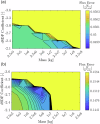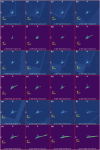Morphology of ejecta features from the impact on asteroid Dimorphos
- PMID: 39952915
- PMCID: PMC11829021
- DOI: 10.1038/s41467-025-56551-0
Morphology of ejecta features from the impact on asteroid Dimorphos
Abstract
Hypervelocity impacts play a significant role in the evolution of asteroids, causing material to be ejected and partially reaccreted. However, the dynamics and evolution of ejected material in a binary asteroid system have never been observed directly. Observations of Double Asteroid Redirection Test (DART) impact on asteroid Dimorphos have revealed features on a scale of thousands of kilometers, including curved ejecta streams and a tail bifurcation originating from the Didymos system. Here we show that these features result naturally from the dynamical interaction of the ejecta with the binary system and solar radiation pressure. These mechanisms may be used to constrain the orbit of a secondary body, or to investigate the binary nature of an asteroid. Also, they may reveal breakup or fission events in active asteroids, and help determine the asteroid's properties following an impact event. In the case of DART, our findings suggest that Dimorphos is a very weak, rubble-pile asteroid, with an ejecta mass estimated to be in the range of (1.1-5.5)×107 kg.
© 2025. The Author(s).
Conflict of interest statement
Competing interests: The authors declare no competing interests.
Figures









References
-
- Naidu, A. P. et al. Orbital and physical characterization of asteroid Dimorphos following the DART impact. Planet. Sci. J.5, 49 (2024).
LinkOut - more resources
Full Text Sources

